华为销售人员的培训教材
- 格式:ppt
- 大小:16.00 MB
- 文档页数:5
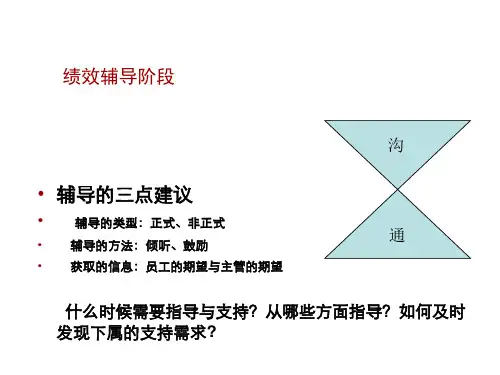

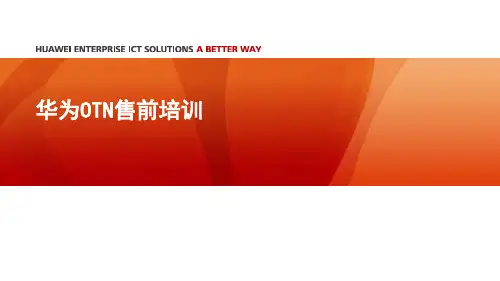
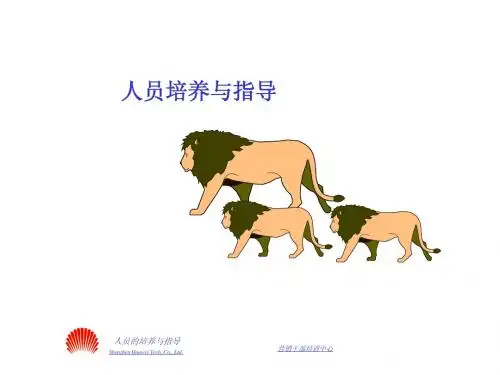

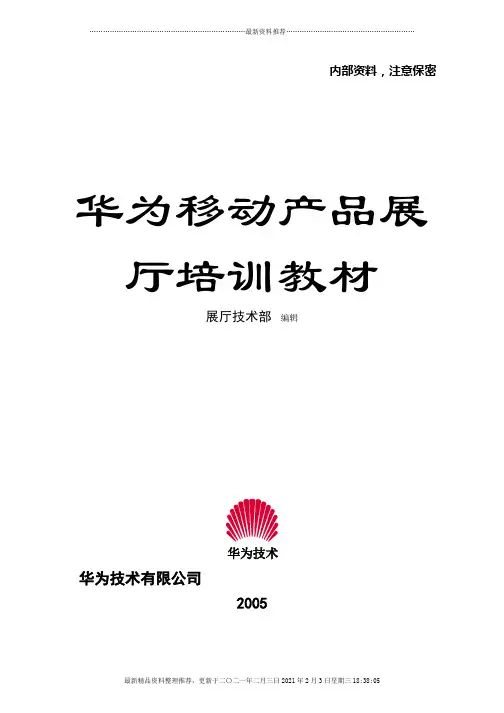
内部资料,注意保密华为移动产品展厅培训教材展厅技术部编辑华为技术华为技术有限公司2005前言本课程通过对华为移动产品发展历程、产品结构、功能、性能、产品卖点、典型应用实例、与竞争对手的比较以及产品发展趋势的讲解,辅以学员自己的讲解演练和展厅讲解实习,使学员不仅掌握华为移动产品主要特点、技术优势、典型应用等知识,而且掌握基本的宣讲技能和技巧。
学完本课程后,学员能够达到:●了解华为移动产品研发、市场应用情况●掌握华为移动产品基本结构、功能和特性●掌握我司移动产品机会点和推广策略●掌握基本宣讲技巧●能够对一般专业性的市场客人和各类非市场客人进行公司产品讲解,为今后的市场营销工作打下良好基础。
目录第一章 WCDMA第一节华为WCDMA概述1.1 Huawei WCDMA introductionHuawei has been investing heavily in 3G and currently there are over 4000 engineers engaged in the R&D of 3G system with global 3G R&D institutes in Shenzhen, Shanghai and Beijing of China and Sweden, India and the United States. Huawei has already successfully deployed its commercial UMTS total solution. In fact, more and more operators are now placing their 3G confidence in Huawei.Huawei is one of the few vendors that have achieved commercial applications (10 commercial networks and over 30 trial networks). Commercial contracts include those with Sunday in Hong Kong, Etisalat in UAE, Emtel in Mauritius, TM in Malaysia and Telfort in the Netherlands.Hong Kong is one of the world's most competitive mobile markets. With high performance, mature product and quick response to customer’s requirement, Huawei was selected by SUNDAY from five global equipment vendors (others are Siemens, Alcatel, Nortel and ZTE).Etisalat, one of the world’s top 500 companies, provides telecommunication services to the United Arab Emirates and is one of the leading service providers in the Middle East Region. On Dec. 24, 2003, Huawei helped Etisalat launch UMTS services in UAE, enabling Etisalat to become the first company in the Middle East and the Arab World to introduce UMTS network.Telekom Malaysia(TM) is the biggest telecom operator in Malaysia and holds a very high position in the telecom market of Asia Pacific. In September of 2004, after strict trial network test and competition among Ericsson, Nokia, Siemens, Alcatel, and Huawei, Huawei won the commercial contract from TM to cover the booming area of Malaysia. In this commercial network, Huawei RAN inter-works with Nokia CN, and proved its excellent interoperability.In Dec.8, 2004, Telfort, Netherlands selected Huawei as their partner on 3G and takes Huawei as the sole UMTS supplier. Huawei will help Telfort to build a nationwide and high-quality UMTS network in Netherlands with a coverage of the whole country including all the main cities like Amsterdam, Rotterdam, Hague, etc. Huawei will deliver a turnkey solution, giving Telfort full UMTS capabilities, interworking with its existing GSM and EDGE platforms and readiness for HSDPA. With Huawei innovative distributed UMTS solutions, Telfort can achieve 30% Opex and Capex saving. Just like the CEO of Telfort said “Huawei's technological and innovative skills are really impressive…We are confident that Huawei will help us to develop innovative and cost effective data solutions for our customers and look forward to a prosperous relationship with them."Here are some key points of this case:1. Huawei will provide an end-to-end solution based on R4 architecture for Telfort.2. Network covers 99% population of the Netherlands3. Replace the existing GSM/GPRS core network with a unified 2G/3G core network4. Distributed Coverage Solution can greatly reduce OPEX and CAPEX, with 30%TCO (Total Cost of Ownership) Saving5. Huawei will deliver a turnkey project1.2 Activities in UMTS industrya) Doing trails and tests with Vodafone, Telefonica, NTT DoCoMo, China Mobile, ChinaTelecom, China NetCom;b) Complete Inter-Operability Test (IOT) with the mainstream equipment vendors:Ericsson, Nokia, Motorola, Nortel, Siemens-NEC, Alcatel;c) Complete IOT for single/dual –mode handsets: Nokia 6650, Motorola A830, NECPeony, NEC C606, Sony-Ericsson Z1010, Qualcomm TM5200/6200, SANYO, LG ;d) Major founder for the Common Public Radio Interface, which is aiming to define apublicly available specification for the key internal interface of radio base stations.e) Establishing 3G open Lab for the development and testing of 3G services withSP/CP, researching WIN-WIN business models and cultivating the 3G value chain;f) Huawei respects IPR. Huawei is one of the few vendors who can design 3G coreASIC. We have our own intellectual properties for 3G and have signed IPR cross-license agreement with Ericsson and Nokia.g) In the MTNet test, which is organized by the Chinese Ministry of Information Industry,Huawei has passed all the 326 mandatory test items and 70 of the total 75 optional test items. Huawei has been ranked No. 1 in both 2 phases of the MTNet test.h)Huawei has also been investing heavily on 3G handsets and is planning to launch aseries of them especially the low-cost 3G handsets.1.3 Major events of Huawei UMTSa) 1995, started R&D on CDMA / UMTS technologyb) Aug. 2001, deployed China’s first UMTS pilot network in Shanghaic) Sep. 2002, dialed the world’s first UMTS intelligent call on CAMEL 3d) Jun. 2003, one of the major founders for CPRIe) Jun. 2003, complete long-distance IP video call based on R4f) Sep. 2003, joint force with Infineon to offer UMTS mobile phone platformg) Dec. 2003, sole supplier of commercial UMTS system for Etisalat (UAE)h) Dec. 2003, sole supplier of commercial UMTS system for Sunday (Hong Kong)i) Aug. 2004, complete world’s first and largest softswitch based R4 network for ChinaMobilej) Sep. 2004, RAN supplier of commercial UMTS system for TM (Malaysia)k) Dec. 2004, sole supplier of commercial UMTS system for Telfort (Netherlands)第一节展台展板讲解词2.1 Poster1: Long-term AccumulationThis poster is self-explaining.2.2 Poster2: Telfort ProjectIn Dec.8, 2004, Telfort, Netherlands selected Huawei as their partner on 3G and takes Huawei as the sole UMTS supplier. Huawei will help Telfort to build a nationwide and high-quality UMTS network in Netherlands with a coverage of the whole country including all the main cities like Amsterdam, Rotterdam, Hague, etc. Huawei will deliver a turnkey solution, giving Telfort full UMTS capabilities, interworking with its existing GSM and EDGE platforms and readiness for HSDPA. With Huawei innovative distributed UMTS solutions, Telfort can achieve 30% Opex and Capex saving. Just like the CEO of Telfort said “Huawei's technological and innovative skills are really impressive…We are confident that Huawei will help us to develop innovative and cost effective data solutions for our customers and look forward to a prosperous relationship with them."Here are some key points of this case:1. Huawei will provide an end-to-end solution based on R4 architecture for Telfort.2. Network covers 99% population of the Netherlands3. Replace the existing GSM/GPRS core network with a unified 2G/3G core network4. Distributed Coverage Solution can greatly reduce OPEX and CAPEX, with 30%TCO (Total Cost of Ownership) Saving5. Huawei will deliver a turnkey project2.3 Poster3: 4 commercial networksa) Introduction of Sunday projectHuawei provides SUNDAY entire end-to-end UMTS solution needed for the 3G launch, including UMTS radio access network, core network, 3G mobile intelligent network, data service platform and applications. The core network adopts soft switch architecture which supports 3GPP R99/R4, GSM/GPRS and TD-SCDMA standard.The 3G network will offer video mailbox, video phone, video conference, Portal, PTT, MMS, IN/CAMEL/MNP and WLAN integration, etc. services. Huawei may also supply SUNDAY with commercial UMTS mobile phones later.b) Introduction of Etisalat projectHuawei provides total UMTS solution with capacity of 160,000 subscribers (phase 1), based on 3GPP R4 architecture, including CN and RAN equipment. Coverage area: Whole country including Abu Dhabi, Dubai, Sharjah, Ajman, etc.Services: Video phone, video conference, live TV on mobile phone, high-speed mobile Internet access and rich data services, etc.With Huawei’s solution, Etisalat GSM customers can migrate to 3G service without the need to change their existing numbers or SIM cards. This is also the world’s first commercial network which supports 2G/3G roaming.c) Introduction of TM projectTelekom Malaysia(TM) is the biggest telecom operator in Malaysia and holds a very high position in the telecom market of Asia Pacific. In September of 2004, after strict trial network test and competition among Ericsson, Nokia, Siemens, Alcatel, and Huawei, Huawei won the commercial contract from TM to cover the booming area of Malaysia. In this commercial network, Huawei RAN inter-works with Nokia CN, and proved its excellent interoperability.2.4 Poster4: Introduction of China Mobile T-ProjectHere is the giant network structure for China Mobile. We are building the TMSC network for China Mobile. The project adopted Huawei’s advanced MSC: softswitch MSC, thus demonstrating the reliability of Huawei softswitch MSC. The position of TMSC1 is very important and they deal with all the long distance traffic between provinces. Based on softswitch MSC, CMCC can save much transmission cost in long-distance calls. The project includes 8 pairs of MSC servers and 32 dual homing MGWs, totally 40,000 E1 ports, building in 31 branch offices of CMCC. The project was completed in August, 2004. It survived the peak of the Chinese Lunar New Year in early 2005 and proved to be of best quality and reliability.2.5 Poster5: Introduction of abundant 2G/3G interworking experienceHuawei has rich 2G/3G interworking experience in commercial networks. Huawei provides the first commercial network which supports 2G/3G roaming for Etisalat, UAE.2.6 Poster6: UTRAN with high performanceThis poster is self-explaining, and may also refers to Key Message: 1.1 UTRAN for Better Coverage and Higher Performance.第一节演示业务介绍3.1 Video on demand (VOD)By using 3G handset as the wireless modem, enjoy the VOD service through UMTS network. The streaming data of high-resolution film is transported from 3G handset to laptop PC via USB port, and displayed on the screen of PC.The downlink speed reaches 384Kbps; the VOD will be one of the most excited services of 3G.3.2 Video Phone(VP)By using 2 UMTS handsets with camera to realized the video Call service,allowing customers to see each other on the screen when speaking to them.VP is circuit-switched based 64K service, will be one of the leading 3G service.3.3 UMTS Video conference interworking with NGN (VC)Customers using a 3G handset dial service access number to join video conference meeting of NGN to realize interworking with NGN VC.VC is one kind of 64Kbps service based on circuit - switched domain, can be used to provide mobile office and online monitor service.3.4 Media Streaming ServiceThe UMTS handset connects to the internet directly, plays the streaming data online such as music,movie, etc. Media streaming service is also one of most attractive service. 3.5 Web-surfing via Bluetooth PDA combined with UMTS handsetUsing PDA with Bluetooth function combines with UMTS handset to realize high speed wireless data service, such web surfing, streaming media playing.Bluetooth PDA supplements the limitation of 3G handset data processing capability; realizes personal mobile internet, mobile office, etc., services.3.6 CMB (Cell Multimedia Broadcast) also called simplified MBMSHuawei is the first vendor to provide the end-to-end multimedia broadcast service over UMTS system in the industry. At the same data usage, services based on CMB, which is a simplified MBMS (Multiple Broadcast Multimedia Service), can be only priced at less than 5% of the present charge for media streaming services. CMB supports media streaming (live video, live TV, commercial video chips, etc.) and downloading services. This innovative service doesn’t require any hardware change, only software upgrade is needed.3.7 Uplink 384kbps ServicesBesides 14.4Mbps downlink rate that Huawei HSDPA solution can provide, Huawei also introduces enhanced solution to support 384k in both downlink and uplink, which can support symmetrical services such as high quality video phone, video conference and high speed for upload applications with large traffic, such as ftp and P2P file sharing.第二节展台设备介绍4.1 UTRAN for Better Coverage and Higher Performancea) Huawei delivers complete set of NodeB family, meeting different needs of operators.These include the 12-TRX/6-TRX indoor macro NodeB, the 6-TRX outdoor macro NodeB, the all-in-one Mini NodeB, and the distributed NodeB (Baseband Processing Unit (BBU) and the Remote Radio Unit (RRU));b) Distributed NodeB, which can greatly reduce OPEX and CAPEX, Separatetraditional macro Node B into two parts: BBU and RRU connecting via optical fiber.The interface between RRU and BBU is open, according to CPRI, Huawei is one of the founders of CPRI. For details, please refer to 1.6.c) For the initial deployment of 3G network, the coverage is most concerned byoperators. With Huawei’s optimal coverage solution, the coverage of UMTS can be as good as that of GSM 900MHz system. These technologies include: power combining with TX diversity, high RX sensitivity of -125dBm, RRU and Tower Mounted Amplifier, 4-way RX diversity, AMR Control and DCCC RRM algorithms, etc.d) The efficiency of traditional LPA is 9%, based on FF technology. Huawei developednew PA technology, DP(Digital Pre-Distortion) plus HPA, which enhance the power efficiency to 18%.e) Huawei has also developed enhanced RTT algorithms that can ensure bothcoverage and capacity in the future. These include the Smart Antenna, the Multi-User Detection, etc.f) The bearer capability of Huawei NodeB is very remarkable. It can simultaneouslysupport up to 8 connections of 384Kbps on the downlink and 7 connections of 384Kbps on the uplink within one single sector-carrier.g) Huawei HSDPA can support 15 codes and full rates up to 14.4Mbps, relies on self-designed ASIC chip.4.2 RAN equipments introductiona) BTS3812E: new Indoor Macro NodeB➢ Smallest NodeB to support 12 CELLs in the industry with height of 1.4 meters and width of 0.6 meters➢ Support flexible configuration mode, such as O1, O2, O3, O4, S3×1, S3×2, S3×3, S3×4, S6×1, S6×2➢ Support flexible diversity mode, such as 2 Rx Diversity, 4 Rx Diversity, 2 Tx Diversity, etc➢ Support Remote Electric Tilt (RET) antenna➢ Support High Speed Downlink Packet Access(HSDPA)➢ High Power efficiency: type1: 18% (DPD: Digital PreDistortion);type2: 28% (DPD+Doherty)b) BTS3812A: new outdoor Macro NodeB➢ Compact design with height of 1.7 meters and width of 0.9 meters➢ Support flexible configuration mode, such as O1, O2, O3, O4, S3×1, S3×2, S3×3, S3×4, S6×1, S6×2➢ complies with the IP55 of International Protection Standard➢ Can work normally under the temperature -40 ︒C ~ +50 ︒C (with heat exchanger)➢ Support flexible diversity mode, such as 2 Rx Diversity, 4 Rx Diversity, 2 Tx Diversity, etca) BTS3802C: All-in-One Mini NodeB➢ All-whether, all-in-one design➢ No equipment room needed, less auxiliary facilities➢ Small size and light weight, easy installation➢ T1, E1, STM-1 transmission, support CES and Fractional ATM➢ Support 128 voice channelsb) RRU3801C: Remote Radio Unit➢ Optical fiber transmission, flexible networking➢ Share base-band and clock modules with host NodeB➢ Adaptable to outdoor environmentc) BBU3806: baseband processing unit➢ Distributed NodeB system with RRU➢ Size: 19’inch box,1U➢ Ambient Temp : -5~+50 °C➢ Single box support 3*1 up to 384voice channels/DL, 256 voice channels /UL, Four box support 3*4 up to 1536 voice channels /DL, 1024 voice channels /ULd) BSC6800: Radio Network Controller➢ Based on commercial ATM/IP platform➢ Modular design, smooth expansion and upgrade➢ 40,000 equivalent voice channels, 1,000,000 equivalent voice subscribers➢ Max. 40K Erl/960M/1600 NodeBs/ 4800 cells➢ Powerful service bearing capability, support 8 kinds of AMR voice➢ Support transport sharing between 2G and 3G4.3 Advanced CS Core Networka) Huawei’s Circuit-Switched Core Network is based on the soft-switching architecture,which is the very pith of the next generation network (NGN). It realizes the separation of carrier and control, featuring smooth evolution, convenient O&M, flexible roll-out and control of services.b) Huawei R4 Core Network supports simultaneous access of both UTRAN and GSMBSS, and also has backward compatibility with 3GPP Rel99. So we call it a unified core network solution.c) The MSC Server and MGW feature large capacity, high density and high-scalability.They both have compact configuration of one single rack, supporting 50,000 subscribers to the minimum. Due to the modular design, they can be expanded all the way to their full capacity, i.e. 1.8 million subscribers with 3 racks.d) The Video Inter-working Gateway (VIG) is a very important network element for therealization of mobile video services. It functions as the interpreter for signaling between systems based on different video standards, e.g. H.323 and H.324M, enabling the inter-connection of video services between UMTS and other telecom systems, e.g. NGN, broadband, Internet.a) Huawei adopts enhanced technologies to improve the quality of voice service,including TFO/TrFO, AMR Control, Comfortable Noise Generation, and Loss Packet Compensation.b) Huawei’s CS CN products have been widely deployed in the commercial network ofChina, Thailand and U.A.E. At the same time, Huawei NGN products, which are based on same platform as Huawei UMTS CS CN, have been deployed in Brunei Telecom. China Telecom, China Satellite Telecom. British Telecom, etc.4.4 CN CS equipments introductiona) UMG8900: Media Gateway⏹Unified media gateway for both mobile and fixed system⏹Smooth evolution to R5/R6, reusing existing hardware⏹Support dual homing features, network-level reliability ensured⏹Support E1/T1, SDH/ATM/POS 155M, FE/GE⏹Support H.324M, multiparty session, etcb) MSoftX3000: MSC Server⏹Abundant services: CAMEL 3, LCS, lawful interception, USSD callback, H.324M⏹Large capacity and high density, 1.8 million subs with 3 racks⏹Support dual homing networking, embedded SG functions⏹Support both layered and non-layered network architecture⏹Support simultaneous access of GSM BSS and UTRAN4.5 Versatile PS Core Networka) Huawei PS Core Network supports the simultaneous access of both UTRAN andGPRS BSS. It can support R99/R4/R5 and smooth evolution to R6 is also guaranteed.b) The GGSN embeds the SSP function and can support Pre-Paid Service (PPS).Huawei has provided the GGSN equipment for AIS of Thailand, enabling its prepaid subscribers to enjoy the attractive data services bringing by GPRS.c) The GGSN has the content-detection functionality. As a result, content-basedcharging can be supported by Huawei PS CN. This function gives operator the freedom of choosing different billing strategy and business modes.d) Due to the content-detection capability, another function which is called OnlyOneAPN can be provided. With this function, the end-users do not need to re-select APN by hand when they are changing to other services. The network will do the routing for the end-user. Re-selection of APN will be invisible by end-users. This function brings more convenience to both the end-users and the operators.e) Huawei’s PS CN has been deployed in 24 countries, 35 operators commercialexperiences, in Asia, Africa, Europe, South America.f) Huawei SGSN/GGSN/CG global application serves more than 12,000,000subscribers PS services and occupies more 47% market share in China Mobile.4.6 CN PS equipments introductiona) SGSN9810: Serving GPRS Support Node●Support both UMTS and GPRS●Capacity up to 1.6 million subs, and 800,000 PDP context simultaneously.●Guaranteed QoS: Diffserv QoS, MPLS, etc.●Support E1/T1, ATM STM-1/STM-4, POS STM-1/STM-4, FE/GE●Special functions: CAMEL 3, LCS, Lawful Interception, GTP HardwareForwarding, 2M Signaling, IPSec, etc.a) GGSN9811: Gateway GPRS Support Node●Support both UMTS and GPRS●handle 1,000,000 PDP context (Single sub-rack), 5,000,000 PDP context(Multiple sub-racks) simultaneously●Excellent quality of service based on Internet differentiated service classes.●Support packet security filtering/ACL mechanism●Support ATM STM-1/STM-4, POS STM-1/STM-4, FE/GE4.7 Experienced Radio Network PlanningHuawei has more than 300 professional UMTS Radio network planning (RNP) engineers locating in over 30 technical support centers worldwide. More than 75% of them hold master or higher degrees. Expertise database, simulation model database and case database of network planning & optimization have been set up to facilitate the RNP.Huawei holds more than 150 3G RNP patents and embodies the belief of RNP into ASIC design. Self-designed software has been developed to field test and network planning & optimization. Huawei has the experience of network planning & optimization in hundreds of 3G projects worldwide, including the commercial 3G network radio network planning in UAE , Hong Kong, Malaysia and NetherlandsHuawei RNP team cooperates with professional international RNP companies(such as WFI and Aircom), invites foreign experts from Europe, USA and Korea to join RNP team and provides professional 3G RNP service globally.About IPRHuawei respects IPR. Huawei is one of the few vendors who can also produce 3G core ASIC. We have our own intellectual properties for 3G and have signed IPR cross-license agreement with Ericsson and Nokia.Till today, Huawei has applied for more than 800 patents Covering UMTS key technologies.About CPRIIn May 2003, Ericsson, Huawei, NEC, Nortel Networks and Siemens created an industry cooperation, CPRI (Common Public Radio Interface).CPRI defines the interface between RE (Radio equipment) and REC (radio equipment control) which is a key internal interface in the radio base station. The aim of CPRI is to define a publicly available specification for the key internal interface of radio base stations.As a founder of CPRI, Huawei’s RRU is fully complied with CPRI 1.1 specification, which means operators can have the benefits of cost-effective and high quality from the whole CPRI industry.第二章 CDMA2000第一节展板介绍1.1Global Applications of Huawei CDMA2000Huawei CDMA2000 has been widely applied worldwide in over 50 countries, in Europe, Eastern Europe, CIS region, middle Asia, Asia & pacific, Africa, Middle East, Latin Americaand north America., such as U.S.A., Mexico, Brazil, Portugal, Romania, Russia, Belarus, Turkmenistan, Kirgizstan, Uzbekistan, Georgia, Azerbaijan, Kazakstan, Ukraine, Thailand, Indonesia, India, Pakistan, Vietnam, Brunei, Yemen, Saudi Arab, Egypt, Algeria, Nigeria, Ethiopia, …. The t otal capacity is c.a. 20 million subscribers. Especially, Huawei is the leading vendor of CDMA450 application with 66% market share worldwide, and 43% market share of CDMA-WLL, 5 commercial EV-DO networks and over 15 DO trial networks.In 2004, American operator (NTCH-CA) selected Huawei as the supplier of her CDMA network. And in the 1st phase, Huawei deployed 2 local networks in California and Arizona in 1900MHz, including SMS & MMS equipments. This is the first time that Chinese telecom vendor supplies CDMA system in United States of America. As we know, CDMA technology is originated from U.S.A. and applied in the first instance, they know CDMA very well, so they understand exactly the keys of CDMA. Huawei passed all the tests via series of excellent features and functions, and then got the first CDMA contract in United States of America.On the project of IUSACELL CDMA2000 network in Mexico, the capacity is 200,000 subscribers to cove 2 areas, section 1 and section 8, there are pairs of sates in each section.In section 1 the system is totally new CDMA2000 system, while in section 8 the system mainly comes from Huawei, the small part is from Motorola. In section 8 the system is at 800MHz frequency, while in section 1 the system is 1900MHz frequency, and the networks are 1X + EV-DO mixed configuration in both section. In phase I, the system is deployed with traditional MSC, and in second phase the SoftSwitch will be deployed. This is a turn-key project including infrastructure, transmission equipments, civil engineering, etc.Huawei provided the first CDMA network in Western Europe, it’s the nationwide CDMA450 network in Portugal, which is 1X + DO mixed network to offer 1X and DO services.CAT is a state-owned telecom operator in Thailand, the existing CDMA system was IS-95 technology provided by Lucent and NEC. The technology is outdated and the revenue was uneasy. So CAT carried out this bidding of CDMA2000 system over the whole country. In this bidding, 5 vendors took part in the bid works, in the phase of technology-evaluate, ZTE and Samsung were washed out. At the end, Huawei is the only vendor for CAT CDMA2000 network. In this network, Huawei will supply 1600 BTS to cover 51 provinces of total 76 provinces in 2 years, including 2.23 million subscribers. And all the BTS is 1X + EV-DO configuration.India is the hottest CDMA market in the world now, the population in India is over 1 billion. And it’s the No.1 CDMA market, so the competition in India is very active. In 2003, through a long time active competition, Huawei got the CDMA contract from MTNL, the capacity is 800,000 subscribers, coverage of Delhi and Mumbai, including OTAF and lawful interception equipments. These two cities are the top 2 biggest cities in India with large areas, dense population and dense buildings. The requirements from operator are very strict and various, Huawei passed all the test items in very short time.Huawei provided IN, CDMA infrastructure and terminals to PTCL in Pakistan. Five local CDMA networks will be distributed in 5 big cities - Islamabad, Lahore, Multan, Quetta and Peshawar, including 1 WIN/SMSC, 1 PDSN, 5 MSC/HLR, 5 BSC, 127 BTS, 305 TRX, BSS capacity is 213K subscribers, NSS capacity is 291k subscribers. Subscriber’s traffic is 0.05Erl/subscriber. In the second phase of PTCL CDMA network, Huawei got 90% NSS capacity, (SoftSwitch + WIN), NSS capacity is 1275K subscribers (including 400K capacity of CDMA450, 875K capacity of CDMA1900), in 9 areas, total contract is over USD80M. Huawei is the biggest supplier.As you know, roaming is very important for the interconnection of networks. In Belarus, the first International roaming of CDMA450 was carry out on Huawei-built BelCel network and another operator Delta Telecom in St. Petersburg Russia.Huawei deployed its CDMA1900 network for Starcomms in Lagos Nigeria. Lagos is one of the most populated cities in the world. Huawei has provided S444 configured single cabinet BTS to provide dense coverage.In Tibet, CDMA450 network is supplied by Huawei. As we know, the terrain is so crude and hard in Tibet, and very harsh climate there. The nomadic people live in very spread regions. Huawei CDMA450 showed excellent features of coverage and service quality. The system provides telephone service in rural area to offer the nomad a link with the whole socity. In some of the places, before they have CDMA450 system, the people had to walk 6 hours to reach the nearest telephone. The CDMA450 system provides not only telephone services but also great changes of everyday life to Tibetans.1.2 End-to-end solution of Huawei CDMA2000Huawei provides CDMA2000 End-to-End solutions including network infrastructure, service platform, user terminals (inc. handsets and terminals) and after-sales service. The solution may be mobile network or Wireless Local Loop (WLL) system. The total network is divided into radio access network, core switch network, and core packet network, service supporting layer, and operation & maintenance center.Huawei offers series of handsets and fixed wireless terminals in different bands and different types to meet the requirements form different customers.Huawei presents complete BTS family to different coverage requirements, and powerful BSC for 1X+DO network. Huawei radio access network can work in different frequency-bands of 450MHz/ 800MHz/ 1900MHz/ 2100MHz, in Huawei CDMA2000, 1X + DO mixed configuration is available, that means, in the same BTS, 1X + DO is supported at the same time, the same BSC supports 1X + DO, and the same OMC supports 1 X + DO.Matured and advanced SoftSwitch is adopted in Huawei CDMA system to replace traditional MSC to perform switching function, including call handling and control, routing,。
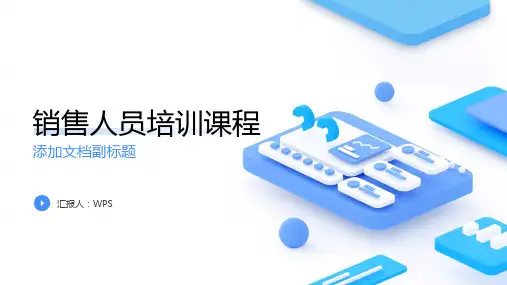
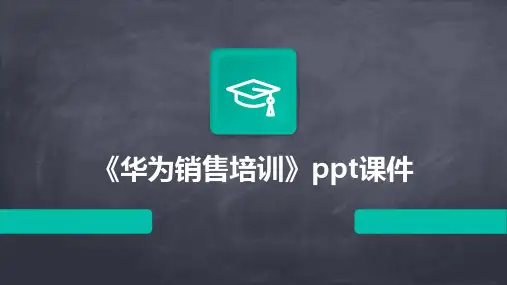
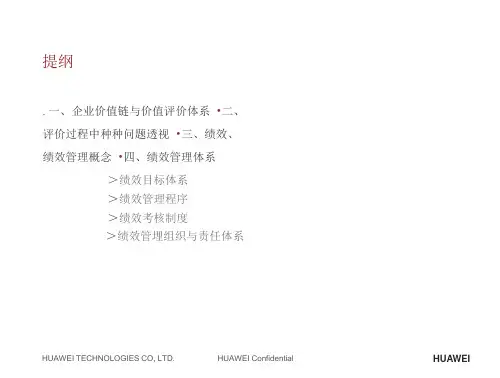

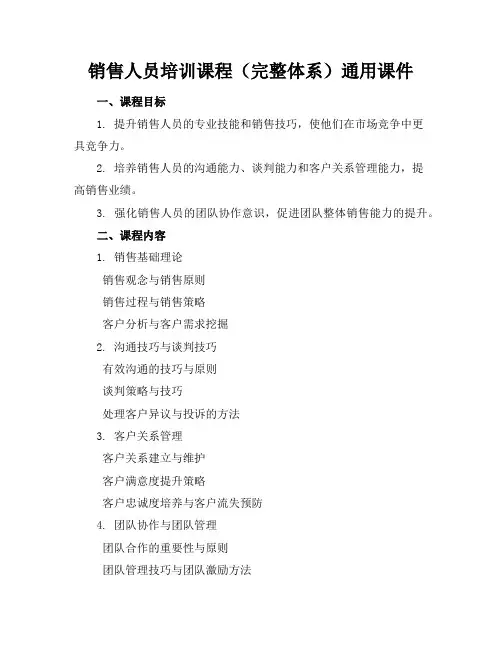
销售人员培训课程(完整体系)通用课件一、课程目标1. 提升销售人员的专业技能和销售技巧,使他们在市场竞争中更具竞争力。
2. 培养销售人员的沟通能力、谈判能力和客户关系管理能力,提高销售业绩。
3. 强化销售人员的团队协作意识,促进团队整体销售能力的提升。
二、课程内容1. 销售基础理论销售观念与销售原则销售过程与销售策略客户分析与客户需求挖掘2. 沟通技巧与谈判技巧有效沟通的技巧与原则谈判策略与技巧处理客户异议与投诉的方法3. 客户关系管理客户关系建立与维护客户满意度提升策略客户忠诚度培养与客户流失预防4. 团队协作与团队管理团队合作的重要性与原则团队管理技巧与团队激励方法团队冲突解决与团队建设5. 自我管理与职业素养时间管理技巧与目标设定自我激励与自我调整职业素养与职业道德三、课程安排1. 理论课程:通过讲解、案例分析、小组讨论等形式,让学员掌握销售基础理论、沟通技巧、谈判技巧、客户关系管理、团队协作与团队管理、自我管理与职业素养等方面的知识。
2. 实践课程:通过模拟销售场景、角色扮演、实战演练等形式,让学员将所学知识应用于实际销售工作中,提高实际操作能力。
3. 互动课程:通过小组竞赛、团队游戏、互动问答等形式,激发学员的学习兴趣,提高课堂参与度,培养团队合作精神。
4. 案例分析:通过对实际销售案例的分析,让学员了解销售过程中的成功经验和失败教训,提高问题解决能力。
5. 实地考察:组织学员参观优秀企业,了解企业销售管理模式,拓宽视野,提高实际操作能力。
四、课程评估1. 课堂表现:观察学员在课堂上的参与度、互动性、学习态度等方面,进行综合评估。
2. 课后作业:通过布置课后作业,检查学员对所学知识的掌握程度。
3. 实践考核:通过模拟销售场景、角色扮演等形式,对学员的实际操作能力进行考核。
4. 案例分析:通过对实际销售案例的分析,评估学员的问题解决能力。
5. 综合评估:结合课堂表现、课后作业、实践考核、案例分析等方面,对学员的学习成果进行综合评估。
华为销售人员培训计划一、培训目标华为作为全球领先的信息与通信技术(ICT)解决方案提供商,销售团队的专业能力和销售技巧对于公司的业务发展至关重要。
因此,为了提高华为销售人员的专业能力和销售技巧,我们制定了以下培训目标:1. 提高销售人员的产品知识和解决方案能力,使其能够深入了解华为的产品和解决方案,为客户提供更专业的咨询和服务;2. 提升销售人员的销售技巧,包括沟通能力、谈判技巧和客户关系管理,使其能够更好地理解客户需求并促成销售;3. 增强销售人员的团队合作能力,建立良好的团队合作氛围和协作机制,提高销售团队的整体执行力和战斗力;4. 培养销售人员的心理素质和团队意识,使其具备良好的职业素养和团队意识,能够承受工作压力和完成团队任务。
二、培训内容基于以上培训目标,我们设计了以下培训内容:1. 产品知识与解决方案能力培训(1)产品知识培训:包括华为公司及其产品的发展历史、组织架构、产品分类及特点、主要竞争对手等;(2)解决方案能力培训:包括行业解决方案和客户案例分析,帮助销售人员了解华为产品和解决方案在各行业的应用和优势。
2. 销售技巧培训(1)沟通技巧培训:包括有效沟通、倾听和表达能力的培训;(2)谈判技巧培训:包括客户需求分析、解决方案提出和价值演示等谈判技巧;(3)客户关系管理:包括客户需求把控、关系维护和客户满意度管理。
3. 团队合作能力培训(1)团队协作培训:包括团队建设、沟通协作、任务合作、冲突解决等培训;(2)销售团队管理:包括目标设定、任务分配、绩效考核、激励奖惩等管理技巧。
4. 心理素质与团队意识培训(1)心理素质培训:包括工作压力管理、情绪调节、成长心态等培训;(2)团队意识培训:包括企业文化、团队精神、合作共赢等培训。
三、培训方法为了实现以上培训目标和内容,我们将采取多种培训方法,包括但不限于:1. 线上学习平台我们将建立华为内部的线上学习平台,提供产品知识、解决方案案例、销售技巧和团队合作等各类培训课程,销售人员可以根据自己的时间和进度进行自主学习。
华为销售培训目标和计划一、培训目标•提升销售人员的销售技能和专业知识,提高销售业绩•帮助销售人员更好地了解产品和解决方案,提高谈判能力•增强销售人员的团队合作意识,培养良好的沟通能力•激发销售人员的销售激情和创新能力,提高客户满意度•建立专业的销售管理团队,提高销售管理水平二、培训计划1. 培训内容和方式•产品和解决方案知识培训:包括公司产品线的了解和功能、性能、优势的介绍,以及针对客户需求的解决方案•销售技巧和方法培训:包括市场分析、客户挖掘、客户需求分析、有效沟通、谈判技巧、成功案例分享等•团队合作和沟通培训:包括团队协作、信息共享、资源整合、有效沟通、有效团队管理等•销售管理知识培训:包括销售目标制定、销售预测、销售计划管理、销售数据分析、客户关系管理等•培训方式:包括专业培训课程、实战演练、角色扮演、实地考察等多种方式,结合在线学习、面对面培训和实际操作2. 培训目标和时间安排•确定培训目标:明确销售人员的培训需求,根据不同岗位和工作职责制定不同的培训目标和内容•分阶段安排培训课程:根据公司业务发展规划和销售人员的培训需求,制定培训计划,并分阶段确定培训内容和时间安排•建立培训考核指标:制定培训考核指标和评估标准,确保培训效果和达到预期的培训目标3. 培训组织和实施•确定培训组织机构:建立专门的销售培训部门或者委托培训机构进行培训组织和实施•选派专业培训师资:根据不同的培训内容和方式,确定专业的培训师资,并进行培训师资培训和考核•制定详细培训计划:根据确定的培训内容和培训时间,制定详细的培训计划和培训日程安排4. 培训评估和持续改进•培训效果评估:根据培训目标和培训目标进行培训效果评估,及时反馈培训效果•持续改进培训计划:根据培训效果评估,及时调整和改进培训计划,提高培训效果和满意度•建立持续学习机制:制定持续学习计划和培训机制,确保销售人员不断提升销售能力和业绩三、培训实例:华为销售培训项目华为销售培训项目以提高销售人员的销售技能和业绩为主要目标,充分考虑销售团队的实际需求和个人职业素质,确定以下培训目标和计划。
引言概述:本文旨在介绍华为培训资料(二),通过对华为培训资料进行全面分析和阐述,帮助读者深入了解华为的培训体系以及相关内容。
华为作为一家全球领先的信息和通信技术解决方案供应商,一直注重培训人才,并在其培训体系中积累了丰富的经验和资源。
本文将从五个大点进行详细阐述,分别是:培训体系介绍、技术培训、管理培训、销售培训和领导力培训。
正文内容:一、培训体系介绍1.华为的培训体系概述2.培训体系的组成结构a.培训规划和需求分析b.培训设计和开发c.培训实施和管理d.培训评估和反馈二、技术培训1.技术培训的重要性2.技术培训的内容和形式a.技术知识培训c.技术实践培训3.技术培训的方法和工具a.在线学习平台b.虚拟实验室c.实地培训和实习三、管理培训1.管理培训的目标和意义2.管理培训的内容和形式a.管理理论知识培训b.管理技能培训c.团队协作培训3.管理培训的实施方式a.培训班形式b.导师制度c.一对一指导四、销售培训1.销售培训的意义和目标2.销售培训的内容和形式b.客户关系管理培训c.市场分析和销售策略培训3.销售培训的评估和反馈a.销售业绩考核b.销售人员调查问卷c.销售管理层面谈五、领导力培训1.领导力培训的目标和重要性2.领导力培训的内容和形式a.领导者的核心能力培养b.团队领导力发展c.战略和变革管理培训3.领导力培训的实施和衡量a.个人发展计划b.360度评估c.案例分析和分享总结:华为作为一家全球领先的信息和通信技术解决方案供应商,其培训体系为其成功发展和员工成长奠定了坚实的基础。
本文对华为的培训体系进行了全面的介绍,包括技术培训、管理培训、销售培训和领导力培训等方面的内容。
通过对这些培训内容和形式的详细阐述,读者可以更好地了解华为培训的全貌,同时也可以借鉴华为的培训经验和方法,提升企业的培训质量和员工的综合素质。
希望本文对读者在研究和实践上有所启发,并对他们的进一步学习和工作有所帮助。
引言概述:本文将重点介绍华为培训资料,涵盖了华为公司的培训理念、培训方式以及培训内容。